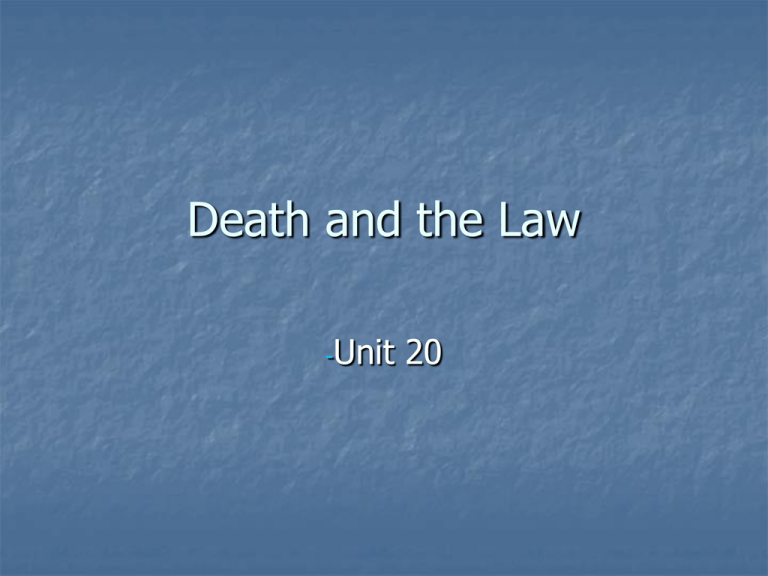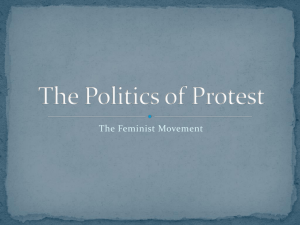
Death and the Law
-Unit
20
Preview
Homicide
Suicide
Euthanasia
Abortion
Homicide
Unlawful killing of a human being
Homicide
1) Murder
2) Manslaughter: a) voluntary; b)
involuntary
3) Statutory offences: a) causing the
death by dangerous driving (Road Traffic
Act 1988); b) Infanticide (Infanticide Act
1938)
Suicide
The act of taking one’s own life voluntarily
and intentionally
Before 1961 – an attempt to kill oneself
resulted in a charge of a criminal offence
Abolished by the Suicide Act of 1961
Suicide
The Suicide Act 1961 abolished the crime
of suicide and the crime of attempted
suicide
By the same Act, it is still an offence to
aid, abet, counsel or procure suicide, and
those who do so can be imprisoned for up
to 14 years; confirmed by the House of
Lords in The Queen on the application of
Dianne Pretty v D.P.P. (2001)
Offences against a foetus
Killing a foetus is not murder or
manslaughter, but there are other
offences which may be charged:
1) child destruction
2) abortion
Child destruction
‘Any person who, with intent to destroy
the life of a child capable of being born
alive, by any wilful act causes a child to
die before it has an existence independent
of its mother, shall be guilty of an offence’
(s1(1) Infant Life (Preservation) Act 1929)
Child destruction
Where a woman is 28 weeks or more
pregnant, this is proof that the child was
capable of being born alive (s1(2) Infant
Life (Preservation) Act 1929)
However, the prosecution can try to prove
that the child was capable of being born
alive even though the foetus was less than
28 weeks
Child destruction
It is not an offence if the act is done with
the ‘purpose of preserving the life of the
mother’ (Bourne 1939)
There is no offence if the pregnancy is
terminated by a registered medical
practitioner in accordance with the terms
of the Abortion Act 1967
R v Bourne [1938] 3 All ER 615
A 14 year old girl was raped by five
soldiers and became pregnant as a result.
An eminent gynaecologist performed an
abortion on her and was charged with the
offence of conducting an illegal abortion.
He was acquitted. Mr Justice Macnaghten:
R v Bourne [1938] 3 All ER 615
“If the doctor is of the opinion, on reasonable
grounds and with adequate knowledge, that the
probable consequence of the continuance of the
pregnancy will be to make the woman a physical
or mental wreck, the jury are entitled to take the
view that the doctor is operating for the purpose
of preserving the life of the mother”
(Defence of necessity in criminal law)
Abortion
The termination of pregnancy before it is
complete with the purpose of destroying
the foetus
Before 1967 it was a criminal act to end,
or to help to end a pregnancy
Abortion
Under s58 Offences against the Person Act
1861 it was an offence to try to procure a
miscarriage.
The offence can be committed by the
woman herself or by another by unlawully
administering any poison or other noxious
thing or unlawfully using an instrument or
any other means
Abortion
By s1(1) Abortion Act 1967, there is no offence
if the pregnancy is terminated by a registered
medical practitioner where two doctors are of
the opinion that:
The pregnancy has not exceeded the 24th week
and that the continuance of the pregnancy
involves greater risk of injury to health of the
woman or any existing children of her family
than if the pregnancy was terminated;
Abortion
At any time during the pregnancy if the
termination is necessary to prevent grave
permanent injury to the physical or mental
health of the pregnant woman
Abortion
At any time during the pregnancy if there
is a substantial risk that if the child were
born it would suffer from a serious
physical or mental handicap
Roe v. Wade (1975)
Facts. Texas statutes made it a crime to procure
or attempt an abortion except when medically
advised for the purpose of saving the life of the
mother.
Appellant Jane Roe sought a declaratory
judgment that the statutes were unconstitutional
and an injunction to prevent defendant Dallas
County District Attorney from enforcing the
statutes.
Roe v. Wade (1975)
Appellant alleged that she was unmarried
and pregnant, and that she was unable to
receive a legal abortion by a licensed
physician because her life was not
threatened by the continuation of her
pregnancy and that she was unable to
afford to travel to another jurisdiction to
obtain a legal abortion.
Roe v. Wade (1975)
Appellant sued on behalf of herself and all
other women similarly situated, claiming
that the statutes were unconstitutionally
vague and abridged her right of personal
privacy, protected by the First, Fourth,
Fifth, Ninth, and Fourteenth Amendments.
Roe v. Wade (1975)
Issue. Do the Texas statutes improperly invade
a right of the appellant to terminate her
pregnancy embodied in the concept of personal
liberty contained in the 14th Amendment’s Due
Process Clause, in the personal marital, familial,
and sexual privacy protected by the Bill of
Rights, or among the rights reserved to the
people by the 9th Amendment?
Roe v. Wade (1975)
Held. The right to personal privacy
includes the abortion decision, but the
right is not unqualified and must be
considered against important state
interests in regulation.
Roe v. Wade (1975)
The abortion laws in effect in most States are
relatively recent, deriving from statutory
changes generally enacted in the latter half of
the 19th century.
At common law abortion performed before quickening
(the first recognizable movement of the fetus) was not
an indictable offense, and it is doubtful that abortion was
ever a firmly established common law crime even when
it destroyed a quick fetus.
Roe v. Wade (1975)
Three reasons for the historical enactment of
criminal abortion laws:
1)the laws are the product of a Victorian social
concern to discourage illicit sexual conduct, but
this argument has been taken seriously by
neither courts nor commentators.
2)the abortion procedure is hazardous, therefore
the State’s concern is to protect pregnant
women.
Roe v. Wade (1975)
Modern medical techniques have altered the
situation, with abortions being relatively safe
particularly in the first trimester.
The third reason is the State’s interest is in
protecting the prenatal life. However, this is
somewhat negated by the fact that the pregnant
woman cannot be prosecuted for the act of
abortion.
Roe v. Wade (1975)
For the stage prior to the approximate end
of the first trimester, the abortion decision
must be left to the medical judgment of
the pregnant woman’s physician, and
may not be criminalized by statute.
Roe v. Wade (1975)
For the stage subsequent to the
approximate end of the first trimester, the
State may regulate abortion in ways
reasonably related to maternal health
based upon the State’s interest in
promoting the health of the mother.
Roe v. Wade (1975)
For the stage subsequent to viability, the
State may regulate and even proscribe
abortion, except where necessary for the
preservation of the mother’s life, based
upon the State’s interest in the potential
of the potential life of the unborn child.
Roe v. Wade (1975)
The Court finds that an abortion statute that forbids all
abortions except in the case of a life saving procedure
on behalf of the mother is unconstitutional based upon
the right to privacy.
However, it does allow for regulation and proscription of
abortion when the statute is narrowly tailored to uphold
a compelling state interest, such as the health of the
mother or the viable fetus. The court declined to address
the question of when life begins.
Roe v Wade (1975)
The historic Supreme Court decision
overturning a Texas interpretation of
abortion law and making abortion legal in
the United States.
held that a woman, with her doctor, could
choose abortion in earlier months of
pregnancy without legal restriction, and
with restrictions in later months, based on
the right to privacy.
Roe v. Wade
The court held that states may prohibit
abortion to protect the life of the foetus
only in the third trimester
Embraced by feminists and denounced by
many Christians
Moral issues
If life is sacred, does a foetus count as a
person capable of suffering harm?
If it does, how is ending its life to be
distinguished from the humane killing of a
living human?
Moral issues
Should the welfare of the unborn prevail
over the distress suffered by a woman
compelled to an unwanted pregnancy, or
endure the anxiety, cost, and difficulty of
bringing up a handicapped child?
Euthanasia
Literally: Good death (from the Greek
words “eu” and “thanatos”)
Also called ‘mercy killing’
Intentional killing by act or omission of a
dependant human being for his or her
alleged benefit
Euthanasia
The question of an individual’s right to die
Euthanasia
Active
Passive
Active euthanasia
Ending of a person’s life by a positive act,
e.g. a lethal injection
Passive euthanasia
Ending of life by an ommission to act, e.g.
a withdrawal of treatment
Courts have not found it easy to
determine the lawfulness of withdrawing
life support from an incurably or terminally
ill patient who is in a persistent vegetative
state (PVS), unable to make an
autonomous decision
Euthanasia
Voluntary: when the person who is killed
has requested to be killed
Non-voluntary: when the person who is
killed made no request and gave no
consent
Assisted suicide
Assisted suicide: someone provides an
individual with the information, guidance
and means to take their life with the
intention that they will be used for the
purpose
Euthanasia and the law
The Netherlands - the first country to
allow so-called mercy killing
Public approval ratings of nearly 90% for
legalisation of euthanasia
Doctors have the right to refuse and
patients have the right to choose
euthanasia
Conditions
Doctors must
A) be convinced that the patient’s request
was voluntary, well-considered and lasting
B) be convinced that the patient’s
suffering was unremitting and unbearable
C) have informed the patient of the
situation and prospects
Conditions
E). have reached the conclusion with the patient
that there was no reasonable alternative
F). Have consulted at least one other physician
G). have carried out the procedure in a
medically appropriate fashion
(Section 293(2) of the Dutch Criminal Code)
Airedale N.H.S. Trust v Bland [1993]
A.C. 789 House of Lords
Tony Bland was a young supporter of
Liverpool F.C. who was caught in the
Hillsborough crush which reduced him to a
persistent vegetative state. He had been
in this state for three years and was being
kept alive on life support machines. His
brain stem was still functioning, which
controlled his heartbeat, breathing and
digestion, so technically he was still alive.
Airedale N.H.S. Trust v
Bland [1993] A.C. 789 House
of Lords
He was not conscious and had no hope of
recovery. The hospital with the consent of his
parents applied for a declaration that it might
lawfully discontinue all life-sustaining treatment
and medical support measures designed to keep
him alive in that state, including the termination
of ventilation, nutrition and hydration by artificial
means.
Airedale N.H.S. Trust v
Bland [1993] A.C. 789 House
Held:
of Lords
The declaration was granted.
Airedale N.H.S. Trust v
Bland [1993] A.C. 789 House
of Lords
The court recognised there was the intention to
cause death. Lord Goff stated to actively to
bring a patient's life to an end is:"to cross the
Rubicon which runs between on the one hand
the care of the living patient and on the other
hand euthanasia - actively causing his death to
avoid or to end his suffering. Euthanasia is not
lawful at common law"
Airedale N.H.S. Trust v
Bland [1993] A.C. 789 House
of Lords
Withdrawal of treatment was, however, properly to be
characterised as an omission. An omission to act would
nonetheless be culpable if there was a duty to act. There
was no duty to treat if treatment was not in the best
interests of the patient. Since there was no prospect of
the treatment improving his condition the treatment was
futile and there was no interest for Tony Bland in
continuing the process of artificially feeding him upon
which the prolongation of his life depends.
Dissenting opinion (Lords Keith
and Mustill)
“It seems to me to be stretching the concept of
personal rights beyond breaking point to say
that Anthony Bland has an interest in ending
these sources of others’ distress. Unlike the
conscious patient he does not know what is
happening to his body…The distressing truth
which must not be shirked is that the proposed
conduct is not in the best interests of Anthony
Bland, for he has no best interests of any kind.”
NHS Trust A v M; NHS Trust B v H
(2000)
The President of the Family Division heard
applications on behalf of two NHS trusts to
be permitted to discontinue treatment in
the cases of two patients who were in
‘persistent vegetative states’
NHS Trust A v M; NHS Trust B v H
(2000)
Applications – not opposed by the
patients’ relatives
The court decided it was not contrary to
Article 2 to allow these patients to die
NHS Trust A v M; NHS Trust B v H
(2000)
Article 2 – did not cover ‘acts of omission’
when it was no longer in the patient’s best
interests to receive treatment, and when it
was shown that ‘they would die swiftly
and painlessly if nutrition and hydration
were withdrawn.’
Re B, 2002
An adult patient was paralysed from the
neck down and kept alive by ventilator
She wished artificial ventilation to be
removed even though she realised this
would result in her death
Her doctors were not prepared to do this
Re B, 2002
The judge held that the right of a
competent patient to request the
cessation of treatment had to prevail over
the natural desire of the medical
professions to keep her alive
Re B, 2002
If mental capacity were not in issue (the
patient was of sound mind) and the
patient, having been given the relevant
information and offered the viable options,
chose to refuse treatment, that decision
had to be respected by the doctors
The right to die?
In 2001, Dianne Pretty was suffereing
from motor neurone disease, a
progressive degenerative illness that was
terminal
The right to die?
She wished to control the time and
manner of her dying, but her physical
disabilities were such that they prevented
her from taking her own life unaided
The right to die?
She wished her husband to help her; he
was willing to do this provided he was not
prosecuted for the criminal offence of
aiding another person to commit suicide
Director of Public Prosecutions refused
The right to die?
Mrs Pretty took her case to court, seeking
a judicial review of this decision, and
claiming that she had a human right to
commit suicide, with assistance
The right to die?
The House of Lords expressed sympathy,
but held that there was no human right to
assisted suicide
Mrs Pretty took her case to the ECHR,
The right to die?
The Court decided that Article 2
guaranteed the right to life, and could not
‘without a distortion of language, be
interpreted as conferring the diametrically
opposite right, namely a right to die’.
The Death Penalty
Capital punishment for murder was
suspended in 1965 and abolished in 1970
Abolished for the remaining offences in
1998
Abolitionists and retentionists
Ruth Ellis
The last woman to be
hanged in Great
Britain
Ellis (28) shot her
boyfriend David
Blakely in 1955
Ruth Ellis
“battered woman syndrome”
Ellis had a miscarriage 10 days before the
killing because Blakely punched her
The Ellis trial
“It was obvious that when I shot him, I
intended to kill him”
The jury reached the verdict in 14 minutes
Ellis executed three weeks later
Ellis Case Reopened
The case reopened in 2003 – the relatives
wanted to replace the decision with a
verdict of manslaughter on the grounds of
diminished responsibility
“Substantial error” – the judge refused to
allow the jury to consider the provocation
defense
New verdict refused
Legal terms
Commit a crime
= izvršiti kazneno djelo
Charge with a crime
= optužiti za kazneno djelo
Sentence
=kaznena presuda
Pass a sentence
= izreći presudu
Legal terms
Reprieve
If someone who has been sentenced in a
court is reprieved, their punishment is
officially postponed or cancelled;
odgoditi izvršenje kazne; osloboditi kazne,
pomilovati
CONDITIONAL SENTENCES
1. Open condition
2. Hypothetical condition
A) present
B) past
Open and hypothetical conditions:
meaning
Open condition: leaves unresolved the
question of the fulfillment or nonfulfillment of a condition, and hence also
the truth of the proposition expressed by
the main clause
Hypothetical condition: conveys the
expectation that the condition will not be
fulfilled
OPEN CONDITION: FORM
(If = ako)
If clause: present simple
Main clause: future (will/shall)
If he is convicted, he will spend the rest of
his life in prison.
If not = unless
Unless he proves his innocence, he will
spend the rest of his life in prison
Hypothetical condition: present
(if = kad bi)
If clause: simple past
Main clause: would/should + infinitive
(present conditional)
If he changed his statement, the jury
would not believe him.
Hypothetical condition: past
(if = da)
If clause: past perfect
Main clause: would have + past participle
(past conditional)
If he had pleaded guilty, he would have
been convicted.
Three types of conditional
sentences: examples
1. If he commits a crime, he will be
punished.
2. If he committed a crime, he would be
punished.
3. If he had committed a crime, he would
have been punished.






